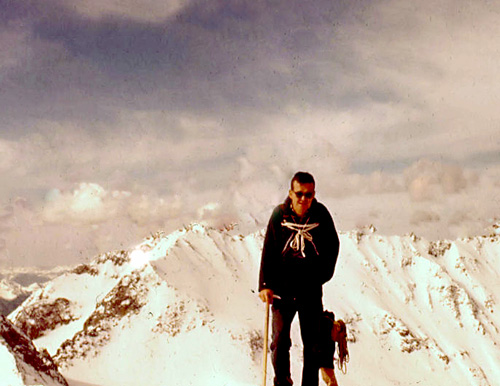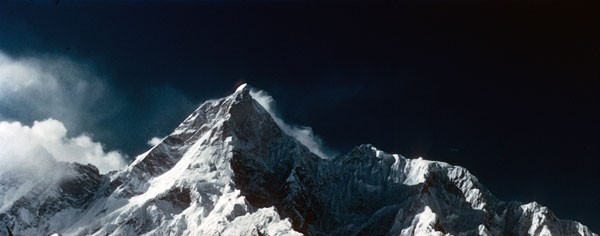Los Alamos Mountaineers
You are here
Ken Ewing
Say 'Good Bye' to Another Fine Friend
By Norbert and Lynn Ensslin, June 3, 2009
Memorial gifts may be sent in memory of Ken Ewing to:
The City College of New York (CCNY)
Office of Development and Institutional Advancement
Shepard Hall, Room 154
New York, NY 10031
Kenneth James Ewing, age 81, passed away on May 30, 2009. Ken was a colorful addition to the Los Alamos community for many years and was a very active member of the Los Alamos Historical Society, the Los Alamos Outdoor Association, the Los Alamos Ski Patrol, and the Los Alamos Mountaineers. He retired from the Lab many years ago, but continued to work part time on various projects over the years. A very nice memorial service was held for Ken at the Los Alamos United Church on June 11th; about 100 people attended.
Ken requested that his ashes be spread on Pajarito Mountain. About 30 of his friends meet at at the Pajarito Ski Hill lodge on June 21st, 2009 and celebrated his life by sharing many wonderful recollections of Ken for a full hour. His ashes were spread by about a dozen friends after a joyful hour of marvelous stories, mixed with much laughing. Each person who participated in spreading Ken's ashes was given a small bag of ashes and spread them were ever they thought appropriate on the ski hill, probably thinking the whole time of Ken and perhaps offering their own small prayers to a man of large connections.
Ken had recently suffered a fall, fracturing his pelvis, and had spent about a week in the hospital and a week at the Sombrillo Nursing Facility. During our visits with him at Sombrillo he seemed to be recovering from his fall. But apparently he had a heart attack and died as a result of that.
To many of the new members of the Los Alamos Mountaineers, Ken Ewing was just the "old" guy who sat in the front row during our monthly meetings, asking questions after each presentation. But to those of us who have known him for many years, Ken was much more than that. Ken worked as a chemical engineer in the WX-3 explosive technology (S-Site) group all of his career. He was famous within that community for having plotted an important set of shock wave data being generated at the lab. Ken was also one of the seven outdoor people who founded the Club in 1952. He remained an active member for the rest of his life – 57 years -- and we were very happy to have a founding member of the club still attending our meetings.
Ken on Wilson Peak, with the Mt. Wilson - El Diente ridge
in the background John Ramsay photo, May 1957
In the 1950's Ken served as President and Treasurer of the Mountaineers, and over several decades he led or participated in many club outings to Colorado, the Tetons, the Wind Rivers, and the High Sierra. He led trips to many Colorado Fourteeners, including Blanca, the Wilsons, Sunlight, Eolus, and Pikes Peak. Ken’s outdoor adventures were not restricted to the US. He climbed some of the Mexican volcanoes in 1982 and 1984 and joined other Los Alamos Mountaineers on Colorado Mountain Club trips to Scotland, England, and Norway. For many years Ken also participated in white water rafting trips with the Los Alamos Explorer Post 20. He was a volunteer in many of the search and rescue practices carried out by the Mountaineers or other state organizations. Ken was also very active in folk dancing, the Pajarito Ski Club, and the Los Alamos Ski Patrol. He taught First Aid classes as well.
As long as he was physically able, Ken helped out in the Mountaineers’ annual climbing school, especially with the snow and ice classes. He had a colorful and dramatic way of describing how to recognize avalanche conditions as he dug down through each snow layer. But the Club's senior members recalled that he was very conservative and careful on snow climbs, and he was especially respected for his judgment in avoiding an avalanche on the north face of Blanca Peak that caught another more-experienced LAMC party during a May 1972 climb.
Many of the Club’s senior members will remember Ken as the leader of their first Colorado Fourteener trip or as the instructor who taught them ice axe techniques during the climbing school. He was a wonderful story teller who still had a remarkable memory up to the day he died. For example, on our last visit with Ken, he entertained us with anecdotes of various trips he had been on with other mountaineers. He recalled that early Mountaineers trips had a 4-person minimum number. One trip with Gregg Brickner ended up being only him, Gregg, and Gregg’s dog Max. He remembered that Gregg and he decided that if you counted how many “legs” were on the trip, it equaled the equivalent of 4 people. Ken’s accurate recollections were extremely helpful in documenting the early history of the Mountaineers.
Ken was certainly one of the Club's most colorful members. His mock crankiness and quirky sense of humor could put people off. He told us strange stories about how to kill grasshoppers, how to cook porcupine, and what to do with frozen sticks of dynamite. But we also learned some important lessons from Ken. He showed us how to make do: "you just have to want less." And he showed how hard it can be to maintain dignity and privacy in one's old age. In the end, we respect his long life as a mountaineer and appreciate his contributions as a trip leader, friend, and story teller. We will miss seeing him in the front row during our meetings.
Ken did not have any close surviving relatives. The Los Alamos Mountaineers and his friends at the Senior Center were his "family." His financial affairs are being well-attended to by Gary DeRosier, President of the Los Alamos Branch of the First National Bank of Santa Fe. He was a member of the United Church.
LAM Official Duties:
Ken was the first Treasurer of the Los Alamos Mountaineers when founded in late 1952, and continued for quite a few years thereafter. Tom Newton who served as LAM's first President remembers that Ken kept the treasury in a paper bag. The club's founding members were Tom Newton, Ken Ewing, Bob Mulford, Liz Gittings, Tom Stevenson, Stan Landeen, and Gene Tate.
Ken served as President twice. He may also have served as Vice-President, but did not recall ever teaching the climbing school. Ken was an active club member, seldom missing our monthly meetings, until his death.
Activities and Recollections:
Ken recalled some anecdotes from the clubs early trips. On a trip to the Wilson Peak and Mt. Wilson area in May 1957, John Ramsay, Ken Ewing, Liz Gittings Marshall, and (maybe) Gene Tate climbed Wilson Peak. Don Hagerman and Harry Hoyt climbed Mt. Wilson. Ken got pulmonary edema for a few hours on Wilson Peak. The others in the party went ahead and came close to getting hit by lightning. Ken could feel the hair rising under his hard hat until a local stroke discharged the field. On a saddle near the Wilsons, there was an old mining hut where they found sticks of frozen dynamite. John Ramsay noticed that the dynamite sticks were exuding liquid, a sign of instability, so he knew that they were dangerous!
On a trip to the San Juan Needles area, the Mountaineers climbed Sunlight, Windom, and Eolus. On this trip, a porcupine showed up and ran into one of the tents. They chased it out, and Ken hit it with his ice axe. The porcupine died, although Ken hadn't meant to kill it, and he felt very badly about that. But since it was dead, they had to eat it. One member of the party was a biology student. He dissected the porcupine, looking for worms in the stomach, but didn't find any. So Liz Gittings Marshall cooked it, which took hours. It turns out that porcupine meat tastes like pine trees, which is what they eat!
Ken also recalled trips to the Southern Wind Rivers (Cirque of the Towers) and to the Northern Wind Rivers (where they camped at Island Lake and climbed Gannett Peak via the glacier). On the 1958 trip to the Cirque of the Towers, the group climbed Warbonnet, Pingora (by the standard route), and an Unnamed Peak. John Ramsay remembers that they had to do a very scary rappel at an angle of 45 degrees to get down from Pingora. John had also been to the Cirque of the Towers in 1951 before he moved to Los Alamos. That trip was probably the second climbing trip ever to the Cirque, after the original visit by the Bonneys.
On two early club trips to the Tetons, one in 1953 and one in 1955, Ken climbed the Grand Teton on each trip and did the free rappel using a (padded) dulfersitz technique, which he dutifully taught to LAM Climbing School students for many years. They also climbed Mt. Moran via the Skillet Glacier. This was too steep for ice axe self-arrest (60 degrees), so they did ice axe belays all the way up and down. They also climbed the South and Middle Tetons.
Chuck Mader climbed Little Bear in August 1955 with Ken on a trip led by Tom Newton. Later Ken, Dave Brown, and Don Liska led beginner rock climbing parties on the Little Bear – Blanca traverse. Ken recalled climbing in Colorado with George Bell and Bob Thorne. These early trips led to the formulation of the Club’s “Articles of War” (the trip rules), which were read annually at one of the meetings. These trip rules included, "the local leader is in charge of all the people on the trip," and "other members of the party can’t leave the trip until everyone is done."
Through the 1980's, the climbing school included a day of snow climbing instruction. This was usually held at Pajarito Ski Area, Santa Fe Ski Basin, or Lake Peak, depending on snow conditions and on whether the ski areas were open or closed in mid-April. The snow climbing day always included instruction from Ken on analyzing snow packs for avalanche danger.
Ken demonstrates ice axe techniques during
the April 1968 climbing school Bob Cowan photo
The Mountaineers used to conduct annual rescue practices at the Back Rocks or the White Rock "Y." Ken often volunteered to be "rescued," and endured many bumps while being lowered in the litter. Once Ken also had the thrilling experience of being lifted up into an army helicopter while strapped into a litter. Ken learned how to carry an injured person by having them sit in a coiled rope and then strapping the rope to his shoulders so they could ride on his back.
Herb Kincey and the Mountaineers carry Ken in a litter during
search and rescue practice at the "Y." Bob Cowan photo, April 1972
Ken once jumped out of a helicopter during a rescue exercise with college students from St. John’s. It has been suggested he was trying to get the attention of one of the coeds. He landed badly and hit his knee very forcefully, leaving him with a permanent limp.
Listen as Ken discusses the possibility of Surviving Nuclear War in this audio podcast (1.07 MB .mp3 file) recorded by the Los Alamos Historical Society. It may bring back a sense of who the man really was.
We'll miss you Ken!
Theme by Danetsoft and Danang Probo Sayekti inspired by Maksimer
